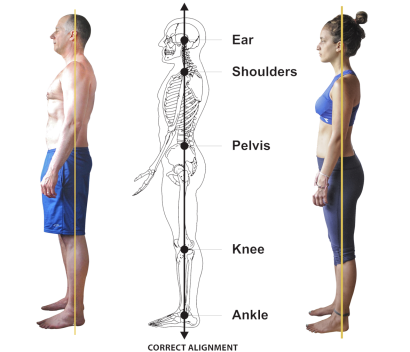What is YogAlign?

YogAlign is . . .
- Yoga practice for optimal alignment using painless and safe body positions and poses
- Unique breathing techniques that tone the core and align posture from the inside out
- Self-massage to stimulate blood flow, nourish tissues and increase kinesthetic awareness
- Fascial freedom of the connective tissue web – a major determinant of our posture, movement and even our moods
- Full body flexibility/strength balance techniques that simultaneously increase efficiency of muscle chains and functional ROM (range of motion)
- Neuromuscular re-patterning techniques encoding aligned posture at the nervous system level
- Activating the psoas/diaphragm connection for core centered movement, enhanced breathing, organ support, and emotional balance
- Global body awareness and ability to meditate in movement directing consciousness in the present moment
- Kindness, compassion and non-judgment towards self and others
- Impeccable in thoughts, speech, and actions
Good Posture with YogAlign
Aligned Posture Is the Focus of YogAlign
What naturally aligned posture does ……
- Opens up biological pathways that increase feelings of happiness
- Keeps your energy level high and can boost confidence
- Lowers fear, depression and anxiety
- Makes you more productive
- Optimizes breathing and movements
- Supports optimal functioning of the integumentary, skeletal, nervous, cardiovascular, endocrine, digestive, elimination, immune, respiratory, digestion, muscular and fascial system
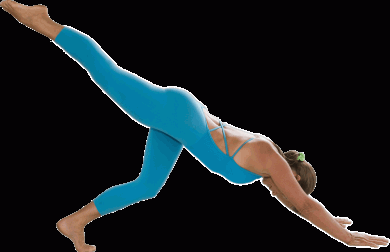
YogAlign Core dog strengthens naturally aligned posture habits
Get your kid body back

YogAlign creates efficient wiring in the nervous system programs responsible for signaling muscle and fascia fibers how and when to contract. YogAlign is easy for anyone of any age or fitness level. Students report that they feel energized, youthful and lifted in the very first class. We call it getting your kid body back.
Babies have good posture because they have not yet been forced to sit in chairs in a right angle body position.
I wanted to do better for my future and myself. YogAlign was the answer. After the 3rd class my whole body felt better. Soon I caught myself going down the stairs without a thought of pain and working in the yard without a consequence.
Since I am now active, I am slim again and my body has an ease to it that I have not felt since I was a young woman.
Thank you Michaelle! YogAlign really works!
Nancy Reed
Wainiha Kauai Hawaii
What is fascia and how does it affect posture?

Fascia Research Congress defines fascia as all collagenous fibrous connective tissues that can be seen as elements of a body-wide tensional force transmission network. Most fascia tissue is composed of collagen except for a few elastin fibers and together they link every part of your body together as one cohesive structure.
On the left is an example of muscle/fascia forces in balance. This is the superficial front or flexor line with the opposing line of pull; the superficial back or extensor line. In the Western world, very few people actually have naturally aligned posture and healthy muscle/fascia patterning that looks like this.Fascia is a sensory organ too
In the past fascia was mainly considered to be an inert ‘wrapping material’ giving mechanical support to our muscles and organs. However recently is has been discovered that there is a rich presence of nerves in the fascia making it the largest sensory organ in the body. Fascia can be the origin of pain perception and since it is so closely woven in and around muscles, the reference to muscle tone in the body should include the combination of fascia and muscle together.Fascia can be dysfunctional
Muscles can become overly tense and chronically contracted when posture is poor. Two thirds of fascia structure is composed of water so hydration is important to keep fascia tissues healthy. Fascia thickens and lays down more fibers in response to localized stress thus becoming a hindrance to movement and good alignment. Body workers can massage people to release restricted myofascia bands on the outer body but this can be a Band-Aid remedy unless one has the tools to also create better alignment programming.When alignment and movement become balanced and efficient, fascia can reorganize on its own from the inside out to support better posture.
Fascia and muscles work together to create movement
The idea that muscle contractions are solely responsible for our movement does not include the elastic recoil abilities of our fascia net. The notion that movement is created by isolated muscles contracting to move bones as levers is a narrow view of how the body engages. Whether running, jumping or walking, a significant part of the energy for movement comes from the elastic recoiling springiness of the fascia tissues as well as from musclePoor Posture is Epidemic

There is an epidemic of poor posture in the Western world; most people shrink in height and go forward into the C-shape spine as they age. Some of the many disorders linked to this C-shaped postural dysfunction are depression, anxiety, weight gain, chronic pain, headaches, osteo-arthritis, vertigo, vision disorders, joint failures, incontinence, digestion, and premature aging
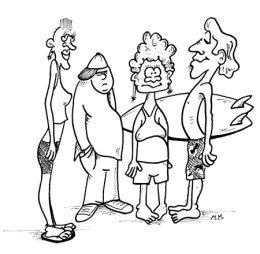
Poor posture is now common in teenagers
Can you see the poor posture in the photos below?
Hint: It is disguised as a yoga pose
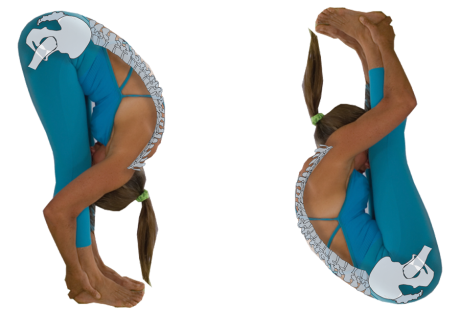
- Standing or seated forward bends with or without twisting while holding straight knees. In this position the trunk, the spine is flexed with muscular tension in a C-shape that undermines the natural curves. The forward motion of the trunk going forward pulls the sacrum upwards with the spine while the pelvis is pulled downwards via the hamstrings which attach to the sit bones.
This stretches the sacral/hip ligaments as the sacrum is literally pulled the opposite direction of the pelvis. The head of the femur (leg bone) pushes deep into the back of the hip socket and has damaged connective tissue called the labrum needed to keep the leg stable in the hip socket.
A study from the Mayo Clinic revealed that straight leg yoga forward bends have caused compression fractures in people with osteoporosis add. - Child’s pose and variation such as sitting cross-legged and bending forward puts the body in a C-shaped spinal flexion and can overstretch the ligaments needed for upright spinal alignment.
- Boat pose puts a huge torque load on the sacral/lumbar region from the weight of the legs being lifted and torqued forward of the pelvis.
- The human body like all of organic nature is made of curves. Staff pose creates an unnatural right angle shape similar to the chair that flattens the natural curves and contributes to hypermobility of the sacral /hip joint.
- Plow pose can compress the cervical discs, pull the head forward, flatten spine curves, stretch nerves and inhibit blood flow in the vertebral arteries.
- Shoulder-stand flexes the cervical spine, pulls the head forward of the spine, compresses discs, stretches ligament and nerve tissue and could inhibit arterial blood flow.
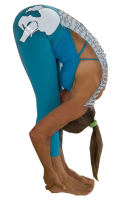
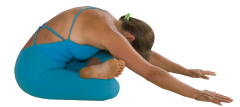
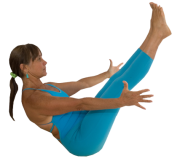
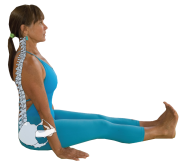

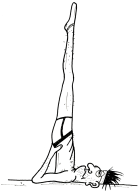
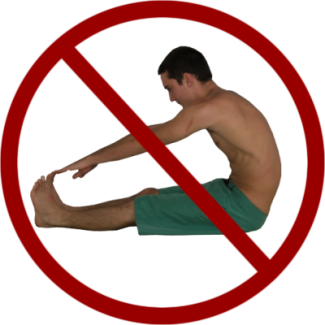
Why you don’t need to do straight leg forward bending to stretch out your back and hamstrings
Eighty percent of people complain of tight back muscles and have the belief that stretching forward with knees straight (as in yoga forward bends) will make the back longer or less tight feeling.
However most of the time, the back and hamstring muscles are not short and tight at all but they are tense because most people are too far forward in their sitting posture. Most back and leg muscles are tense and locked long and actually need movements that will recruit them to shorten.
In yoga forward bends and toe touching with straight knees, there is a stretch reflex that comes on automatically that removes tension in tissues to prevent injury. This automatic reflex provides a false sense of relief for about 20 minutes after stretching forward that fools many people into believing the back actually gets longer or less ‘tight’. In YogAlign you learn that it simply makes no anatomical sense to try and stretch out parts of your body while putting the spine in a C-shape and putting joint structures at risk.
# 1 From Standing:
With the feet together, begin to lean your trunk slightly forward without letting your knees bend. Notice the torque or tension that occurs in the lumbar sacral region. Do not go any further or try to touch your toes. Bend your knees to come back to standing.From sitting: Begin to lean your trunk slightly forward while flexing your ankles and keeping your knees from bending. Notice the torque or tension that occurs in the lumbar sacral and/or the hamstring region. Do not go any further or try to touch your toes.
While walking: Keep your knees from bending and try to walk. Notice how difficult it is and whether you feel pain or pressure anywhere in your body.
#2 From standing:
Draw your navel in tightly to shorten your abdomen as it happens in forward bending. Notice how this action tilts your pelvis backward while flattening the sacrum and reversing the essential lumbar or low back curve of the spine. Try to walk while holding the navel area contracted and notice how you feel. Try to lift your arms and notice how you feel. Try to breathe and notice how you feel. Try to laugh and notice how you feel.What people believe forward bending with straight knees does for the body:
Removes tension in the back, calms the nerves and makes the hamstring muscles longer.What forward bending with straight knees actually does to your body:
Compresses the hip socket by bringing the chest towards the thighs.Creates weakness of the back and butt muscles while simultaneously creating laxity of ligament tensional forces needed to keep the joints stable and the body in an upright position
When you bend forward to stretch your hamstrings and back with straight knees, you are also flexing your spinal column into the C-shape and flattening your sacral platform. Does this make any sense? Ask your body. It does not lie.
Conclusion:
Since muscle tension is controlled by the nervous system, stretching does not actually change the shape or length of a muscle. Balancing the forces of tension in the body is what makes sense. Pulling on the ‘parts of the body’ will not change the big anatomical picture of the body as a global structure.Flexibility can be a liability
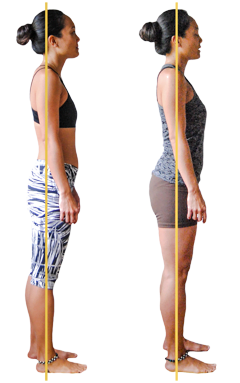
Hypermobile yoga teacher who gained joint stability and eliminated back pain with YogAlign
If you have very loose and mobile joints, you are in more danger because you may not feel pain or tension in positions that should feel restricted. Joint tissue is more avascular then our skin or our muscles, lacking in blood flow and afferent or sensory nerves. This means that you may not feel any ‘damage or pain’ but in the long run, ligament tissue that is not designed to stretch becomes lax, making joints unstable.
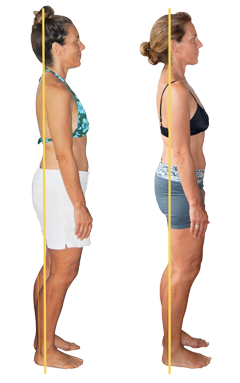
Lisa corrected her alignment with YogAlign and her chronic knee pain disappeared
I have always been very active until knee pain and inflammation was at the point where I couldn’t walk very far, let alone hike, dance, or stand for long periods of time. Walking down stairs was the worst.
I went to physical therapy, did acupuncture, massage, Rolfing, and was told by orthopedists that knee replacements could be in my future.
I started her classes in the fall of 2014 and after the first private session, I noticed a huge difference in my posture and after only 6 weeks of YogAlign, it was amazing because I had no more pain. My whole body is now in better alignment therefore my joints are not compromised or stressed. After 3 months of classes I can hike, dance, and stay on my feet for 12 hours. (I am a wedding planner and my job requires that.) Gone are the mornings I wake up with a tight back and sore knees. I’m telling you, try YogAlign and you will be amazed with the results. I cannot thank Michaelle enough for her courageous work that is often contrary to traditional yoga and stretching poses. Anyone and everyone can easily do YogAlign and everyone will benefit. I’m in for life. Thanks, Michaelle.
Women get 80% of all hip surgeries
Women get 80% of all hip surgeries in the US and quite possibly the biggest reason could be laxity in the joint itself. Women are naturally more flexible than men and have hormones that create more laxity in the hips during pregnancy and childbirth. Practicing hip openers and forward bends can create even more laxity in the hips, sacrum and spinal column. Ligament tension is necessary for stability as these joints assist us in being upright. These are some of the biggest reasons for the injuries and hip joint surgeries that are becoming more frequent in the yoga world.
Passive Stretching does not make your body perform better
Everyone seems to believe that we need to ‘stretch our muscles’ in order to improve body performance or flexibility. However, research is revealing that pulling on individual muscle bodies does not help them function better.
“Stretching is not a biological-physiological necessity but perhaps a socio-cultural construct. Indeed it seems that only humans engage is regular, systematic stretching. Passive stretching cannot improve active control as it only engages the sensory component of the movement system.”
Eyal Lederman, ( 2015, Fascia in Sport and Movement)
In recent years, the value of stretching our muscle parts in an isolated fashion has been eroded by research showing that it is not a beneficial practice and actually seems to be causing more harm than good.
“Stretching as a warm-up before and after exercising has failed to show any benefit for alleviating muscles soreness, it provides no protection against sports injuries and vigorous stretching before an event may even reduce sports performance.” (Andersen, 2005, Journal of Athletic Training) (Herbert, 2011,Cochrane Database Syst Rev.) (Simic, 2012,Scand J Med Sci Sports)
Give up the idea that you should stretch. Animals don’t. They do something called pandiculation. For example, dogs contract their voluntary muscles in their legs and back after they have been sleeping or resting and they always bend their knees in the downward dog position. This is very different than the passive stretching techniques that humans have adopted.
In YogAlign, we do not try to stretch our ‘parts’ but instead learn rebalancing techniques to realign our structure from habits ingrained from chair sitting, stretching, and/or compartmentalized exercises. A YogAlign practice helps one to stay aligned whether walking, bending forward to pick something up, sitting or doing sports. All positions and movements simulate how the body is designed to move in real life function.
YogAlign gives you back ‘lost real estate’ in your body.
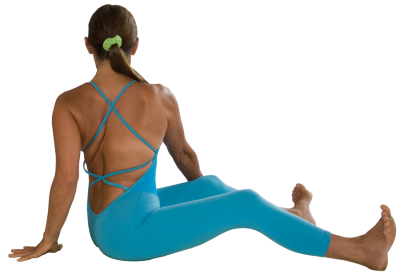
Breathe Your Way to a Pain-free life
As you gain the tools that will connect all parts of your body with better oxygenation, nutrition and proper alignment, the bio-intelligence can then heal the joint tissues that have become thin, damaged or arthritic. The best way to do YogAlign is to walk, run, dance or move with a focus on maintaining upright posture. Eventually naturally aligned posture becomes innate and just the way you are naturally…. without effort.
With YogAlign you can get back into good posture without painful positions, compressive twists or toe touching poses. You can literally breathe your way to a pain-free life.
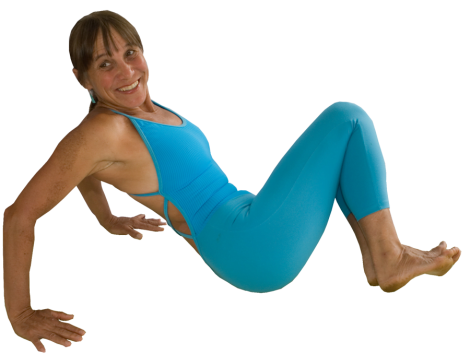
Yoga for better posture..
Interview by Yandara yoga with Michaelle on the YogAlign approach

